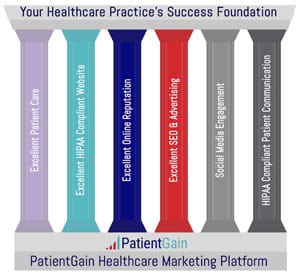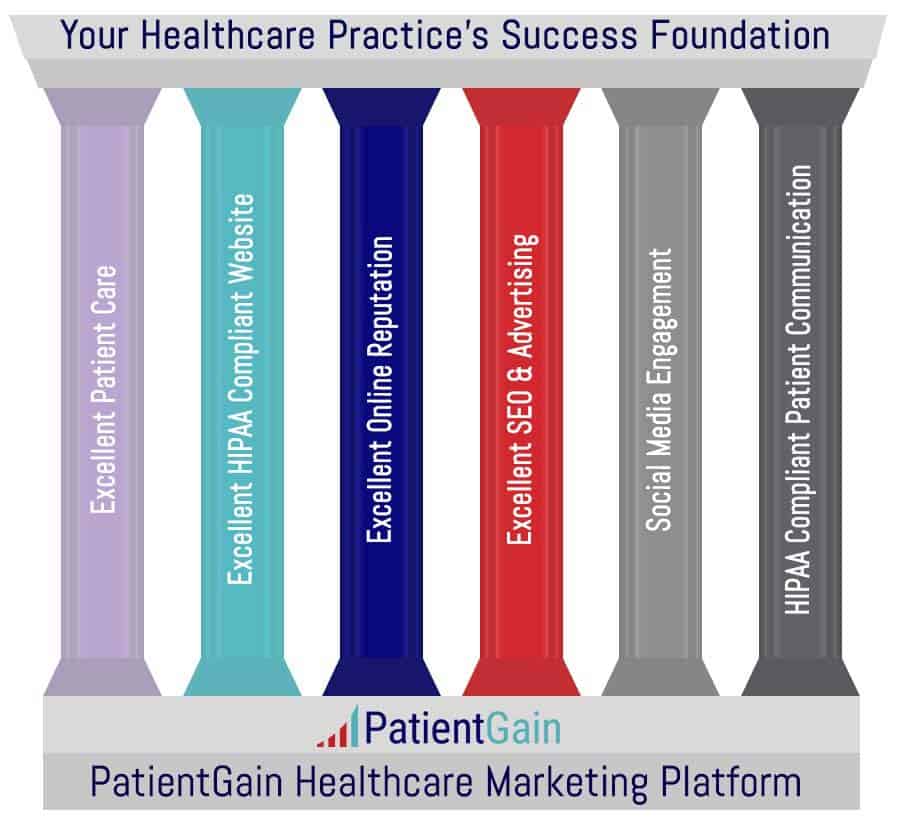Expert Digital Marketing For Doctors Pricing $799 to $1999/month
Physician digital marketing is a way for doctors to promote their practice and services online. It can help doctors increase their patient base, build trust, and improve their reputation. As a medical practice, you need to be online if you want your business to grow. The main foundation and the most important aspect of your digital marketing asset is a high perfomance, HIPAA compliant, high-conversion, A/B tested medical or dental website. If you are new to medical digital marketing, you can start with an introduction.
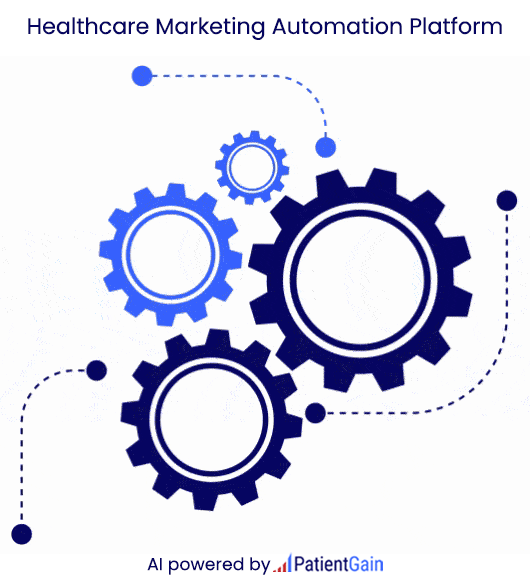
While traditional marketing strategies can still be useful in the right circumstances, digital marketing has taken the lead when promoting healthcare businesses. Acquiring high digital presence should be a key pillar in your overall marketing strategy. It is not hard to get your medical practice online. The challenge is doing it properly so your marketing money is most effective, check the GOLD service $799/mon and PLATINUM service $1399/mon designed for healthcare practices and based on success of hundreds of successful healthcare practices in USA.
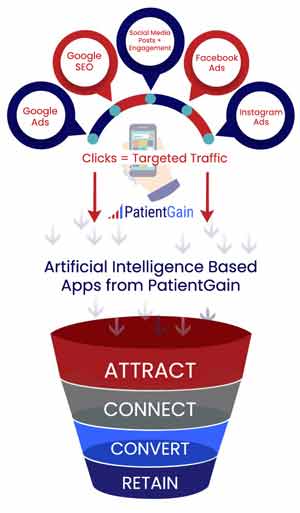
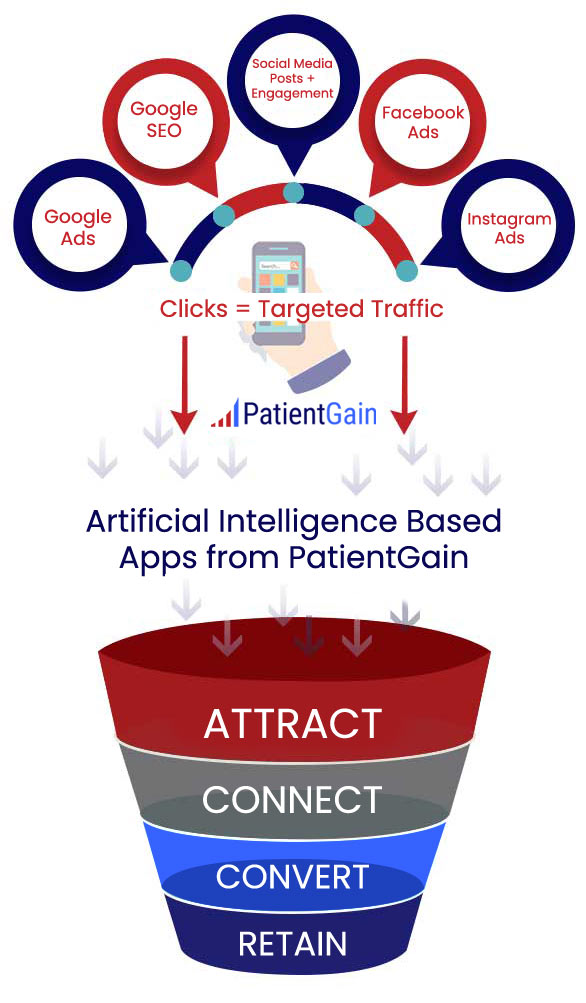
10 Key steps to digital marketing for doctors
In today’s competitive healthcare landscape, digital marketing has become essential for doctors to enhance their visibility, attract new patients, and grow their practices. By leveraging online platforms and strategies, healthcare providers can build trust, improve patient engagement, and optimize their online presence.
1. Website Optimization
A professional, user-friendly website is the foundation of your digital medical marketing strategy. It should provide clear information about your services, be optimized for mobile devices, and be easy to navigate.
- SEO: Optimize your website for search engines by using relevant keywords, meta descriptions, and on-page SEO techniques to improve your ranking on Google.
- Mobile-friendliness: Ensure that your site is mobile-responsive, as a significant portion of online searches are conducted on smartphones.
- Clear and concise content: Use straightforward language to explain your services, qualifications, and showcase patient testimonials.
- Fast loading times: Speed up your website’s loading time to enhance the user experience and improve search engine rankings.
Example of ROI from website optimization of a PLATINUM customer of PatientGain.
In this dashboard – You can see that in May there were 137 effective leads from the SEO optimizations. This customer is not running any ads on social media or Google. Major focus is to improve the organic medical SEO rankings so the patient acquisition cost is extremely low. In the month of June, the number new effetcive leads is 190 and in July it is 203 effective leads. If medical SEO best practices are used, we see very good ROI from organic medical SEO rankings.
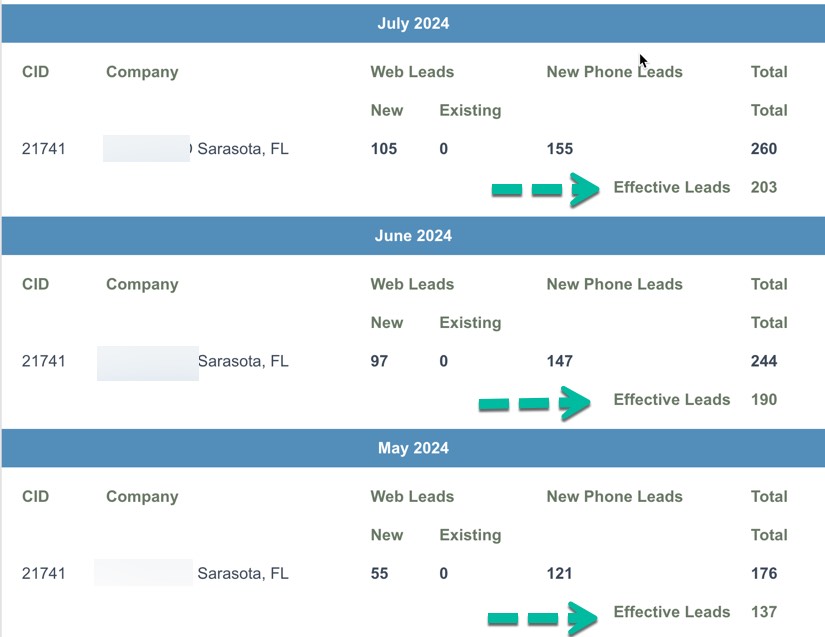
2. Pay-Per-Click (PPC) Advertising
PPC advertising allows you to target potential patients based on their search behaviors, demographics, and geographic location.
- Google Ads: Target patients searching for healthcare services in your area with specific keywords (e.g., “pediatrician near me”).
- Social Media Ads: Use platforms like Facebook, Instagram, and LinkedIn to reach patients with tailored ads, boosting your online visibility.
3. Social Media Marketing
Social media is a powerful tool to engage with your audience, share valuable content, and create a trusted online presence.
- Content creation using social media posts: Regularly share health tips, articles, videos, and updates on your practice to inform and engage your audience.
- Social media engagement app for doctors: Interact with followers by responding to comments, messages, and questions, fostering patient relationships.
- Paid advertising on social media for doctors: Promote important posts or services to expand your reach to a broader audience.
4. Email Marketing
Email marketing for doctors is a direct way to stay connected with current and prospective patients, offering personalized updates and promotions.
- Build an email list: Encourage patients to subscribe to your newsletter by offering useful content or appointment reminders.
- Provide valuable content: Share health tips, clinic news, and promotions to keep your subscribers engaged.
- Track performance: Use tools to monitor open rates, click-through rates, and conversion metrics to assess the effectiveness of your email campaigns.
5. Content Marketing
Content marketing establishes you as an expert in your field by offering valuable information and education to your audience.
- Blog / Informative pages: Write informative blog posts about relevant health topics, treatment options, and preventive care.
- Infographics: Add infographics and contribute articles to industry publications or local outlets to enhance your credibility.
- Videos: Create educational videos that explain medical procedures or share health advice in a simple, accessible format.
6. Online Reviews and Reputation Management
Patient reviews are critical for healthcare providers. A strong reputation online can significantly impact a patient’s decision to choose your practice.
- Encourage patient reviews: Ask satisfied patients to leave positive reviews on platforms like Google, Yelp, and Healthgrades.
- Respond to reviews: Address both positive and negative feedback professionally and promptly to show your commitment to patient care.
7. Local SEO
Optimizing your online presence for local search ensures that your practice is visible to patients searching for healthcare providers in your area.
- Google My Business (GMB): Ensure your GMB listing is complete with accurate business information, photos, and patient reviews.
- Local directories: List your practice on local directories such as Healthgrades, Local chamber of commerce, and Yelp to increase your visibility.
8. Patient Testimonials
Highlighting positive patient experiences can build trust and credibility for your practice.
- Showcase success stories: Post patient testimonials on your website or social media to help potential patients feel more confident in choosing your services.
- Video testimonials: Consider creating video testimonials to add a personal and engaging touch.
9. Texting from your medical website
With the rise of texting, allowing patients to send your practice a secure/HIPAA compliant text message immediately increases your conversion rates, and increases patient satisfaction.
- PatientGain’s 2-Way texting app engages patients right when they land on your website. Increasing conversion of patients. In addition, you can use the app to send transactional messages also, for example confirming an appointment. Our apps are integrated. Texting app saves data in HIPAA compliant CRM. And there is integration for autoresponders, speech-to-text, and Email responses, auto-text-back, promotions, online payments.
- Patients read 97% of text messages. 71% to 88% of your patients are mobile. They are browsing on their cell phones and visiting your website. They also prefer to communicate with you using texting/sms
10. Analytics and Tracking: Real-Time Medical Marketing Dashboards
To ensure the success of your digital marketing efforts, it’s important to track the performance of your campaigns using data-driven insights.
- Key Performance Indicators Are Organized In One Place & Always AccessibleAnalytics: Track your website leads, patient behaviors, and conversion rates to optimize your digital strategies.
- Improved Communications: Access to these dashboards improves internal communications. Instead of a dental practice owner asking for a general report, they can ask for specific information about metrics they see in a dashboard. This allows for targeted reports to be generated, saving everyone time, and getting everyone on the same page about the data in question. Business owners may also find that external communications become more efficient as well. With data more readily available, marketing campaigns can be put together quickly. As a result, helpful, engaging, and informative campaigns can target potential patients easier.
- Campaign adjustment: Continuously tweak your strategies based on data to ensure you’re reaching your target audience effectively.
Key question asked by providers : What are some ways to get my medical practice online to be found by potential patients who need my services?
1. Get at website that is based on high SEO (Learn more about SEO) and loads very fast, you also need a high-conversion website
2. Hire a good medical marketing company to help you. It is no longer a simple task
3. Invest in technology to beat your competition
4. Establish an advertising budget that is focused on digital marketing first
5. Follow the success of other providers in similar fields, use a proven marketing system, rather than trial and error
6. Take some risk ( calculated risk ). Business world requires taking some risk. Read about medical marketing ROI.
7. The most profitable practices keep the patient experience as the focus of their practices.
8. The top performing practices understand that digital marketing is important, but they also focus on traditional marketing strategies. They are also “minglers” and also have at least one source that allows them to build a goodwill in the local community. For example one of PatientGain’s top provider is an advocate for local blood bank. Another practice offers job openings to US veterans first.
Most of the physicians believe that by simply having a nice looking wordpress website, with information about the clinic, services they provide and a contact information, they should start receiving inflow of patients. Truth is that this is minimum or basic steps for modern digital marketing. At Patientgain.com we receive inquiries from physicians and practice managers everyday, and we can see that majority of time, the discussion starts with the website. However, the truth is that there is a lot more than having a nice website. There are 2 basic concepts 1) Getting the right patient to your website. 2) Once the patient/client lands on your website, if they do not take any action, it has no or low value to your practice. If they take an action, like contacting you, calling you, sending a text, requesting an appointment etc – This is called “conversion action”. So if 100 patients/clients visit your website this week, and 11 of them take an “action”, this is called conversion. So your conversion rate will be 11%. What is a good conversion rate?
Marketing services for doctors
Physician marketing can be:
1. Offline Traditional Marketing
2. Internet or Digital Marketing
We highly recommend digital marketing for 99 percent of healthcare practices. Both of these approaches have merits and limitations, costs and ROI (Return On Investment) is not the same. Online advertising is a big part of digital marketing. It can be the most expensive part of your overall online marketing plan. The actual cost of advertising is always extra, with any service. Some clinics/doctors are very aggressive and spend $1000 per day (or more) and some spend $1000 a month on advertising. We also have few clinics/doctors who do not spend any money on advertising. Our data shows that proper advertising produces more patients for 99 percentage of the clinics/doctors.
Offline Traditional Marketing
Examples of offline advertising for physicians
Offline advertising remains a powerful tool for physicians to build their practice and attract new patients, especially within their local community. Print materials provide a tangible reminder of your services and work well for local targeting.
1. Print Advertising
- Local Newspapers: Advertise in community newspapers to reach local audiences.
Example: A half-page ad promoting flu shot availability during flu season. - Magazines: Place ads in health, wellness, or lifestyle magazines relevant to your target audience.
Example: A feature in a regional health magazine about women’s health services. - Direct Mail: Send postcards, flyers, or brochures to homes in your area.
Example: A postcard offering new patient specials or highlighting your practice’s services.
2. Radio Advertising – Radio ads can effectively reach commuters and community members who prefer traditional media.
- Local Radio Stations: Advertise during peak commute hours to reach a wide audience.
Example: A 30-second spot promoting your practice as a convenient option for same-day appointments or urgent care services. - Health Tips Segments: Sponsor a health-related segment on local radio.
Example: A brief discussion on staying hydrated during summer heat waves, ending with your practice’s contact information.
3. Television Advertising – TV ads offer a visually engaging way to reach a broad demographic.
- Local TV Stations: Run commercials highlighting your services, especially for specialized care.
Example: A 15-second ad introducing your dermatology clinic and its cosmetic treatments. - Public Service Announcements (PSAs): Create educational PSAs to position your practice as a community health advocate.
Example: A PSA about the importance of annual check-ups, sponsored by your clinic.
4. Community Engagement – Community involvement establishes trust and positions your practice as a local healthcare leader.
- Health Fairs and Expos: Host a booth at local health events to promote your services.
Example: Offering free blood pressure checks or consultations at a community health fair. - Sponsorships: Sponsor local events, schools, or sports teams.
Example: Your clinic’s logo on banners for a charity run or local sports team uniforms. - Educational Seminars: Organize workshops or lectures on relevant health topics.
Example: A seminar on managing diabetes or stress reduction techniques.
5. Outdoor Advertising – Outdoor ads increase visibility and can target high-traffic areas in your community.
- Billboards: Place eye-catching ads on busy highways or near your practice.
Example: A billboard reading, “Need a Family Doctor? Accepting New Patients—Call Us Today!” - Transit Advertising: Advertise on buses, subways, or transit shelters.
Example: A bus ad promoting urgent care services for non-emergency needs.
6. Partnerships and Referrals – Collaborations expand your reach through trusted local networks.
- Local Businesses: Partner with gyms, wellness centers, or pharmacies to cross-promote services.
Example: A flyer at a local gym promoting sports physicals or injury care. - Healthcare Providers: Build referral networks with specialists, dentists, or optometrists.
Example: A referral program where a specialist recommends your primary care practice for general wellness needs.
7. Promotional Items – Practical items keep your practice top of mind for patients.
- Branded Merchandise: Distribute items like pens, notepads, water bottles, or first-aid kits with your clinic’s name and logo.
Example: Hand out branded hand sanitizers at community events. - Health Kits: Provide mini wellness kits with your branding.
Example: Include a thermometer, bandages, and a card with your contact details.
8. In-Office Advertising – In-office advertising ensures your existing patients are aware of all the services you provide.
- Patient Education Materials: Display brochures, posters, or educational videos in your waiting area.
Example: A brochure about the benefits of annual physicals. - Referral Cards: Provide current patients with cards to refer friends or family.
Example: Offer a small incentive like a free wellness check for successful referrals.
9. Event Sponsorships – Event sponsorships enhance your visibility while contributing to community goodwill.
- Charity Events: Sponsor charity runs, school fundraisers, or local festivals.
Example: Have your logo on event materials and a booth offering free health advice. - Community Programs: Support local programs like free health screenings or vaccination drives.
10. Yellow Pages and Local Directories – While less common, printed directories still reach specific audiences who prefer traditional methods.
- Traditional Listings: Advertise in printed directories used by older demographics.
Example: A full-page listing showcasing your clinic’s services and contact information.
11. Additional offline strategies
- 11. Car Wraps – Cost of full wrap is between $2,500 and $5,000. With proper messaging and exposure, compared to other outdoor advertising, your vinyl car wrap pays for itself within the first few months on the road! However this type of marketing is not for every medical practice.
- 12. Local movie theaters – This has been effective for many providers. However it is difficult to measure the net impact. Local movie theaters marketing costs $1000 to $4,000 per month depending on your location.
- 13. USPS Mail drops – Still the easiest way to be placed in your local patient’s mail boxes, marketing costs $500 to $1,000 per mail drop per 10,000 residents, depending on your location. Learn more how United States Postal Service can help you advertise.
Summary of Offline Advertising Strategies
- Print Advertising: Local newspapers, magazines, and direct mail.
- Radio and TV: Local stations, PSAs, and sponsored segments.
- Community Engagement: Health fairs, sponsorships, and educational events.
- Outdoor Advertising: Billboards and transit ads.
- Partnerships: Collaborate with local businesses and healthcare providers.
- Promotional Items: Distribute branded merchandise or health kits.
- In-Office Advertising: Patient education materials and referral programs.
- Event Sponsorships: Support local events for visibility and goodwill.
- Traditional Listings: Use Yellow Pages or local directories.
- Newspaper Inserts: Include targeted promotional flyers.
By combining these strategies, physicians can effectively reach local audiences, build trust, and attract new patients. Newspapers (see list of top newspapers in USA) – Yellow pages (see list of Yellow pages in USA)
Internet or Digital Marketing for Doctors
Online marketing, is also known as digital marketing services for physicians can be further divided into sub areas
- Search or PPC ( Pay-Per-Click ) Marketing – Google, Yahoo and Bing are very common examples for this type of advertising. Some physicians equate this to Search Advertising. There are hundreds of variations within this category alone.
- SEO – Search Engine Optimization – This refers to techniques and content placed of your website so search engines like Google can find you and rank you higher for specific keywords. Consumers (your patients) use mobile devices and computers to type in phrases like “pain management houston tx” and search engines display relevant listings. More and more patients are speaking to devices rather than typing text. This is call Speech Based SEO.
- Local SEO Optimization – There are over 200 directories for medical practices. Most of them have no to marginal impact on your practice. The most important business listings are 1. Google Business Page 2. Facebook Business Page 3. Yelp Business Page. 4. Healthgrades and few other healthcare specific directories are also important. As a practice manager, you need to make sure that your listings are accurate and that you are posting on Google Business Page and Facebook Business Page regularly.
- Speech Based SEO – New Emerging Area – As more patients are “speaking” to devices.
- Display Advertising – Interest Based Advertising – there are many variations.
- Video Advertising – Advertising on YouTube for doctors can be effective.
- Social Media Advertising – Interest Based & Demographic Advertising. Can be visual, textual, video based.
- Mobile Advertising – Based on mobile ads and user’s location.
- Geo-Targeted / Geo-Fenced Advertising – Used by Apps, Search, Social Media and Location Aware apps, among others.
- Re-Marketing – Based on a User’s Past History, Past Interests and Predicted Behavior.
- Similar Competitive Interest Based Advertising
What is digital-first medical marketing?
Medical practices operate very differently than they did even a decade ago. The technology and systems available to them today were barely even conceived back then. Doctors who started their profession in the 1990s may feel like they are in a completely foreign world today compared to how they operated. Many of the things providers work with today have a “digital-first” perspective. In other words, the implementation of digital systems is practically a requirement for a medical practice to be successful. As medical practices have progressed, so has medical marketing. Medical marketing must also have a digital-first perspective to effectively get enough patients for a business to grow and succeed.
Patients also want a digital-first medical practice to serve their needs and actively look for one online. Below are some things to consider when creating a medical marketing plan for a medical practice. The experts at PatientGain.com can help you develop a digital-first medical marketing plan for your practice.
What are some things a digital-first patient wants from their medical practice?
Many patients are looking for an excellent digital experience when looking for healthcare. A bad experience will likely influence their opinion of a provider overall, making it unlikely that they will pursue future services there. A medical practice must provide an excellent digital experience for its patients. Although telemedicine did not start during the COVID-19 pandemic, it quickly accelerated its adoption and usage for wellness appointments and other health-related screenings. Digital-first choices like these need to be embraced by medical practice so they can compete with others. Although the COVID-19 pandemic will end one day soon, the digital trends spurned by it are likely to stay.
There are several things that patients look for when a digital-first approach is considered when they look for a medical practice for care. Generally, they want to see:
- Convenience
- Digital Communication
- Protection and privacy of their personal health information
How does convenience influence the decision-making of a potential patient?
A patient with a digital-first approach will want several things when looking for a medical provider in terms of convenience. Overall, they want it easy to find the providers they need for their healthcare. Many patients today embrace the concept of online appointments and will want to be able to schedule them online. In fact, over 33% enjoy having this choice. After an appointment, they will also desire a way to pay their bills online instead of mailing a check-in. Finally, they will want to be able to review the billing, payment, and other medical protocols on the website so they can make an informed decision.
Many of these requirements for convenience will occur outside the medical practice’s facility. A digital-first health experience can make the practice accessible online through digital systems. The “convenience factor” plays a massive role in the provider selection process for potential patients. Many patients will switch providers because they can be provided with more convenience and choices.
How can a medical practice make things more convenient for its patients?
The vast majority of current and potential patients will eventually come in contact with a medical practice’s website. With that in mind, it is often the most effective place to improve the convenience for patients by making features available on it. However, patients will need to find it first before they reach that website. Implementing quality search engine optimization and content marketing campaigns on site is vital. These improvements will help boost the organic rankings of a website. A medical practice marketer needs to make sure the right target search keywords, including long-tail keywords and short-tail keywords, are in place throughout a website so that it appears in search results for their target audience. Content marketing is needed to ensure the content on a site is kept updated, fresh, unique, and authoritative. Search engines love these traits when it comes to content and often will push those sites as being more relevant for search results.
Another thing that patients find to be helpful and convenient is intelligent medical engagement chatbots. These robust programs help and encourage patients to use various “self-service” aspects of a website rather than relying on a staff member via phone or email to assist them. Many of the questions and issues a current or potential patient may have before making an appointment are similar. A chatbot can be programmed with the most common questions and their answers to assist patients on a site, allowing them to make a conversation without additional assistance.
Online scheduling has become an increasingly vital requirement for many medical websites. Forcing patients to wait until business hours to call and make an appointment is no longer wise. With so many other medical practices using online scheduling, a practice that does not risk their patients taking their business elsewhere. Online scheduling allows patients to make their appointment at any time of the day, no matter where they are. This digital-first technology is a must and should be implemented as soon as possible.
Finally, online payment of bills is a no-brainer for medical practices. A HIPAA-compliant payment processing system is a win-win for both a patient and a practice. First, it allows patients to pay their bills without finding an envelope, stamp, and write a check. For medical practices, they get their money faster, making funds available for business much quicker. They no longer have to send staff members to banks to cash checks or make cash deposits. Digital payment of patient bills also makes it easier for medical practices to keep their bookkeeping accurate.
How is digital communication a valuable convenience to offer patients looking for a digital-first medical practice?
Communication between a provider and their patient is critical for the health of the patient and their overall experience in a medical practice. Typically, a patient must travel to a medical practice for an appointment. This requires them to allow additional time for travel. Providing the ability to have appointments in a video or voice can be very attractive for patients looking for extra convenience. Patients also need help keeping their ever-busy schedules organized. A practice that will help them with appointment reminders will be greatly appreciated. Finally, communication is critical when patients give feedback to a practice, and a medical practice can send follow-up messages to patients after appointments. Patients greatly appreciate this kind of two-way communication and consider it good customer service, which over 50% say builds brand loyalty.
How can a medical practice ensure it has good digital communication for its patients?
Making digital communication available to patients may seem like a big haul, but it can be accomplished. A medical practice should think about the patient’s journey and see how they can improve digital communication for a patient. For example, most patients will:
- Search online and find a medical practice that meets their needs.
- Book an appointment
- After receiving confirmation for an appointment, wait until the day of the appointment.
- Travel to the medical practice for the appointment.
- Receive a bill for the services or treatments they received
- Pay the bill or set up a payment plan.
- If needed, a patient will receive the results of any medical tests conducted during the appointment.
- The medical practice will follow up with a patient for additional appointments if needed. If so, the journey begins again.
Inadequate communication between a practice and a patient can cause them to abandon this journey altogether and seek out a new medical provider. Bad communication often leads to confusion and a poor overall experience. There are several ways to implement digital communication that will improve the overall experience for patients.
What are some digital-first solutions to digital communications that can be highlighted in medical marketing plans?
One of the most significant difficulties for patients getting the care they need is physically getting to a doctor to be seen. Video or voice appointments, known as telemedicine, can help expand the accessibility to patients. Video telemedicine needs to be made over a secure, HIPAA-compliant connection to ensure no rules are violated. Video and telephone medical appointments are not always available for every service that a patient may need. For example, if a patient needs a DOT Physical that requires testing and in-person assessment, a video appointment will not work. However, a telemedicine appointment to determine the symptoms of a sinus infection can save time and get patients the treatments they need faster.
Appointment reminders are a powerful digital communication tool that many medical practices can benefit from implementing. Patients today have schedules that are far busier than ever before. Handwritten appointment reminders are not as effective as they once were. A missed appointment impacts the health of a patient and the finances of a medical practice. Automated appointment reminders can help cut down those missed appointments. Reminders via email or text message (or both) are often the most effective methods to get reminders to patients. Missed appointments dropped by 88% according to a recent study looking at the use of appointment reminders.
Finally, medical practices can improve digital communication by providing a secure way for patients to contact providers. An encrypted, HIPAA-compliant message submission form is an excellent way for patients to send questions, concerns, and other private health information to a practice. These messages are stored on a HIPAA-compliant dashboard on a secure server to be addressed by the staff member assigned to them. Another popular way to give patients a way to communicate with a medical practice is to allow patients to engage in two-way texting. Again, these texts need to be sent to a HIPAA secure dashboard and not a random cell phone sitting on the front desk of a medical practice. Making it easier to communicate with providers is an added convenience that many patients seek in a digital-first medical practice.
How can a medical practice ensure patients’ health information is secure and will remain private?
The vast majority of patients want to keep their medical information private and secure. Trust in doctors has remained high over the decades but has recently decreased. It can be reinforced by showing patients that not only does a medical practice take data privacy and security seriously but also has technology and protocols in place to maintain it. Security and privacy can not be fully advertised in marketing materials, showing every detail. Promoting exactly how something is kept secure will generally make it not secure in the long run. However, there are some policies that a medical practice should implement to boost the security of patient data and privacy.
What are some ways a medical practice can increase the security and privacy of patient’s data?
A medical practice needs to have the security of their patient’s data as top priority. Under HIPAA regulations, medical practices are responsible for every bit of data sent to their medical practice. Data not only needs to be secured when it is sent to a medical practice, but it also needs to be stored and, when needed, deleted securely.
A medical practice should have firewalls, antivirus software, and encryption software on their computers and websites. This level of security generally is not the expertise of doctors or even staff members. However, third-party website developers should be well versed in this area to make a HIPAA-compliant medical website. Most data breaches are not because software is defeated but because of humor errors. For example, if a medical practice forgets to pay its yearly fee for a secure website, that security can be turned off, resulting in a data breach.
A medical practice also should limit access to systems to staff who need to use them. They each should have their login with a secure password so their access can be documented and audited. Staff members should not write passwords down on post-it notes either and have them sitting next to their computer. A medical practice should also not force staff to regularly change their password, as this leads them to make less secure passwords so they can remember them easier. Finally, 2-factor authentication is often encouraged. This involves a staff member logging in and then being sent via text or email a one-time use passcode to enter in for access. 2 Factor authentication is often used by financial institutions and has recently been an option on social media and email accounts.
What is the purpose of digital advertising for a medical practice?
The purpose of digital advertising for a medical practice is to attract new patients, retain existing ones, increase visibility, and position the practice as a trusted healthcare provider in a competitive market. Digital advertising allows medical practices to engage directly with potential patients, providing them with relevant information, promoting services, and encouraging actions that lead to appointments, consultations, or inquiries.
Here are the key purposes of digital advertising for a medical practice:
1. Increase Patient Acquisition
- Goal: Attract new patients to the practice who are actively seeking medical services.
- How: Use digital ads on search engines (Google Ads), social media, and display networks to target individuals who are searching for specific treatments or healthcare services.
- Example: Running Google Ads for terms like “urgent care near me,” or Facebook Ads targeting individuals looking for wellness services, such as weight loss or skincare treatments.
2. Enhance Brand Awareness
- Goal: Make your medical practice more visible and recognizable within your local community or target audience.
- How: Display ads, social media campaigns, and video ads increase the presence of your practice by introducing your brand, expertise, and services to potential patients.
- Example: A medical spa could run social media ads showcasing their services like Botox or facials, emphasizing their unique offerings and building brand recognition.
3. Promote Specific Services or Treatments
- Goal: Drive interest and appointments for specific services or treatments offered by the practice.
- How: Create targeted digital ads that highlight services that patients may be looking for, such as annual check-ups, wellness treatments, dental services, or specialty care (e.g., chiropractic, physical therapy).
- Example: A dental clinic could run digital ads promoting teeth whitening or emergency dental services to attract patients with specific needs.
4. Improve Patient Retention
- Goal: Engage current patients and encourage repeat visits or ongoing care.
- How: Use email marketing, retargeting ads, and social media campaigns to stay top-of-mind and remind patients of follow-up appointments, seasonal checkups, or new services.
- Example: An urgent care clinic may send retargeted ads to past patients offering flu shots or preventive care services during flu season.
5. Drive Online Appointments and Inquiries
- Goal: Facilitate the booking process and generate more appointments directly from digital ads.
- How: Use clear calls-to-action (CTAs) in your digital ads, such as “Book Your Appointment Today” or “Schedule a Consultation,” and direct users to an online booking system or contact form.
- Example: A fertility clinic could use digital ads with a “Request a Free Consultation” CTA to encourage people to learn more about fertility treatments and schedule an appointment.
6. Establish Credibility and Trust
- Goal: Position the practice as a trustworthy, credible healthcare provider in the eyes of prospective patients.
- How: Use patient testimonials, doctor bios, awards, and industry certifications in your digital ads to build trust with new patients.
- Example: A medical spa could use video ads featuring patient testimonials or before-and-after photos of popular treatments, building credibility and showcasing real results.
7. Target Specific Patient Demographics
- Goal: Reach the right audience for your medical practice based on factors like location, age, gender, interests, or specific health concerns.
- How: Use detailed demographic targeting on platforms like Google, Facebook, and Instagram to hone in on people who are most likely to need your services.
- Example: An orthopedic clinic might run Facebook ads targeting middle-aged people or athletes in a specific region who might be seeking treatment for joint pain or sports injuries.
8. Measure and Optimize Campaign Effectiveness
- Goal: Track the performance of digital ad campaigns and make data-driven adjustments to improve results.
- How: Use analytics tools to monitor KPIs (click-through rates, conversion rates, cost-per-click, etc.), allowing you to fine-tune your ad targeting, messaging, and budget allocation.
- Example: Tracking how many people book appointments after clicking on an ad helps optimize future campaigns by focusing on the most effective ad creatives and targeting strategies.
Digital advertising for a medical practice is an essential tool for building patient acquisition, enhancing retention, promoting specific services, and establishing trust with potential patients. With targeted campaigns and measurable results, it helps medical practices stay competitive in a digital-first world.
The experts at PatientGain.com are available to help you create a high-performance healthcare website that embraces digital-first technologies. Contact us today and let us show you what we have done for other practices across the country with our digital-first medical marketing plans!
